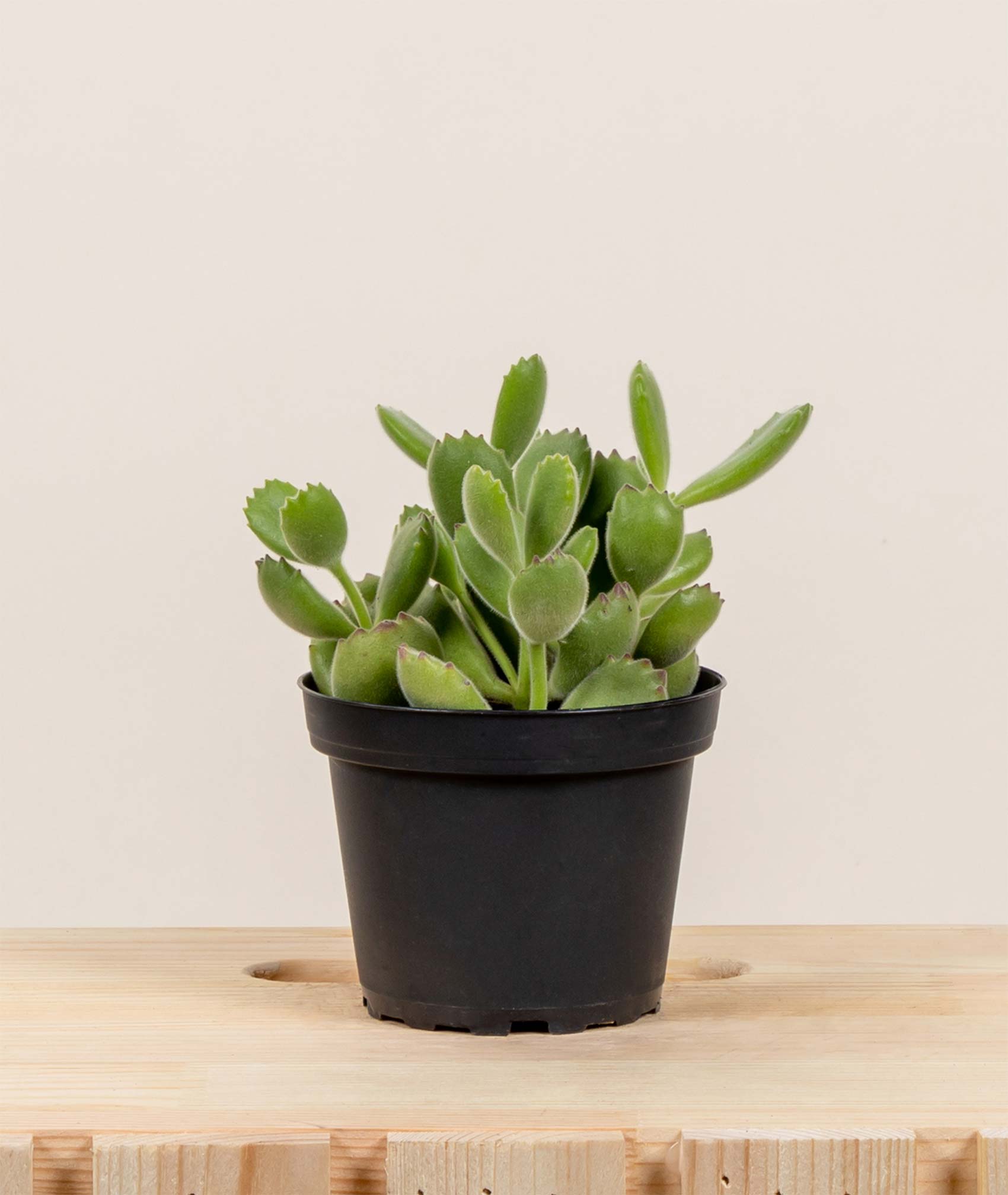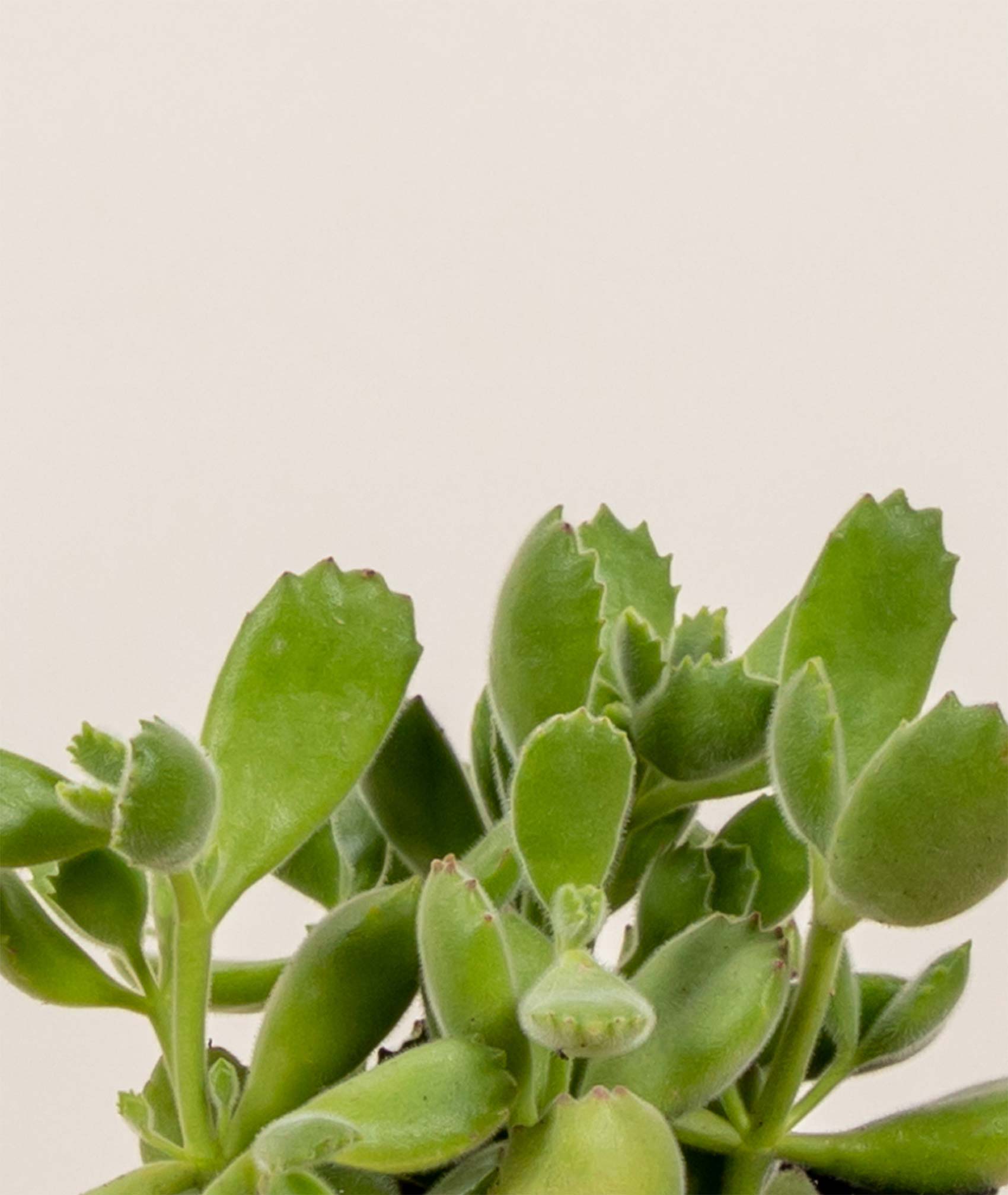
Bear Paw Succulent
$18
 Plastic grow pots come in different colors, you may receive a black or rust colored pot.
Plastic grow pots come in different colors, you may receive a black or rust colored pot.
Don’t let the name of this succulent scare you; in fact, the leaves resemble an adorable cub’s paw than a mighty giant bear! It is small in size and can be placed just about anywhere you can think of. Its green leaves are fuzzy and have tiny purplish points that look like small teeth. This succulent thrives under bright, indirect sunlight and requires watering whenever the soil is really dry — it’s that easy! Succulent Bear’s Paw is a great addition to your home or office setting if you want to brighten and improve your space.
6 hours of bright, indirect sunlight per day. Direct sunlight may give it a slight sunburn, but it won’t dramatically harm these resilient desert plants.
Regular deep watering during the summer season or when there is no rainfall. You can do this by supplying ¼ cup of water (for smaller paws) and one to 1 ½ cups of water (for large) paws at least once a week to keep them healthy.
65° – 75°F
Related Products
Bear Paw Succulent
The Bear Paw Succulent is a striking and fabulous houseplant to have if you can get your hands on it. Also known as the Cotyledon Tomentosa and belonging to the Crassulaceae family, the Bear Paw is a fun, dashing little plant with bright green, fuzzy leaves that look similar to a bear’s paw. The Bear Paw makes for an excellent houseplant on a bookshelf, nightstand, or any other place in your home with indirect lighting.
Let’s take a closer look at the Bear’s Paw, how to care for it, how safe it is, and plants that are similar.
What is a Bear Paw Succulent?
The Bear Paw Succulent is a rather peculiar, small succulent plant known for its fuzzy green leaves and its red toothed edges resembling a bear’s claw.
Also known as its scientific name, Cotyledon Tomentosa, the Bear’s Paw is a quaint-looking plant that can provide a bit of texture and color to any outdoor garden or indoor living space. A few other nicknames this plant is known by are Bear’s Claw Plant, Bear Paw Cactus, and Kitten Paw Plant. The Bear’s Paw is native to South Africa and is a part of the Crassulaceae family.
Generally, the Bear’s Paw is a low-maintenance plant and does not require too much effort to grow. Here are the specifics of growing this unique succulent.
Plant Size
The Bear’s Paw is usually a fast-growing succulent that can grow to 20″ inches tall, sprawling out its bright green leaves like a wild bear. The fuzzy, chubby leaves can grow to about 1.5″ inches long. Although this plant is relatively small, the teeth-shaped leaves and bell-shaped flowers are sure to pack a powerful bite. The flowers on the Bear Paw can be a pink, orange-red, or light yellow color.

Light
The Bear Paw can thrive as either a houseplant or an outdoor plant. If you want this plant to grow indoors, place it near a south-facing window or in an area that will receive at least 6 hours of indirect light daily.
If you are planning on growing your Bear’s Paw outside with your other succulents, the first step is to find a place where it is nice and shady. These succulents enjoy indirect sunlight, so a spot that is somewhat shaded yet bright enough to feel the sun’s warmth is preferred.
Watering
The Bear’s Paw is similar to other succulents because they love when their roots are soaked but just enough for them to be able to start to dry out between watering. In the summertime, Bear’s Paw succulents need regular deep watering when there is little rainfall. Watering about once a week should suffice during the summer. About one 1 and ½ cups of water for fully grown Bear Paws and one ¼ cup of water for smaller ones should be enough to keep them happy.
With Bear’s Paw, the trick is never to let the soil completely dry out. You want to make sure the soil is damp but not soaked. Especially in the wintertime, when rain is more prone to occur, make sure that you do not over-water your Bear’s Paw and drench the soil if there is any excess water accumulating.
Temperatures
Because the Bear Paw is native to the warm weather of South Africa, this plant enjoys growing in the heat. The best temperature for the Bear’s Paw is between 70º and 85º Fahrenheit. Anything below 45º Fahrenheit can harm this plant.
Feeding
For feeding, the Bear’s Paw tends to need a light balanced all-purpose water-soluble succulent fertilizer. Feed this fertilizer to your plant twice a month during its growing period, usually during the summer.
Why Choose a Bear Paw Succulent for Your Home?
The Bear’s Paw Succulent is a lovely little plant that can add a bit of color to any succulent garden or some peace to your living room. But besides being an aesthetically pleasing plant, there are quite a few benefits to adopting a Bear’s Paw plant.
Cools the Air Inside Your Home
According to a research paper from the International Journal of Science, Environment, and Technology, several succulent plants have been shown to reduce a room’s temperature. Although you will need to stock up on multiple Bear Paws to receive the maximum benefits, the study shows that succulents can significantly cool down a heated room.
Improve Indoor Air Quality
Houseplants can absorb air pollutants, creating cleaner air for us to breathe. A study conducted by NASA has shown how indoor plants can absorb volatile organic compounds from the air and convert them into food for their survival. This can help people who have certain allergies or respiratory illnesses such as asthma.
Reduces Your Stress Levels
Aside from improving the air quality in your home, having an indoor plant can help reduce your stress levels. It has been shown that having indoor plants can create a peaceful and calming atmosphere that can help your mental state and keep you focused. Even a tiny plant like a Bear’s Paw can help ease your mind and make you feel more at peace.

Are Bear Paw Succulents Good Indoors & Outdoors?
The wonderful thing about the Bear’s Paw succulent is that it is extremely versatile and can thrive indoors or outdoors.
If you want to keep your Paw inside, all you need to do is find a nice spot where it can receive plenty of indirect light, and remember to water it about once a week with well-draining soil. The Paw provides many benefits when growing inside and does so without being overly flashy. The Bear Paw can be a great addition to any home decor and provide a bit of natural life inside.
On the other hand, your Paw can also make for a great outdoor plant. When planted outside, you may have to take into account the weather and possible pests. The Bear Paw Succulent can add plenty of flavor to a succulent outdoor garden. With its dashing green leaves and furry texture, the Bear Paw can be a wonderful addition to any outdoor area.
Are Bear Paw Succulent Pet and Children Friendly?
Although the Bear Paw Succulent is generally considered non-toxic, it is still best to keep away from children and pets. This plant can be mildly toxic to pets and people, but not too severe where it is considered life-threatening.
However, a plant closely related to the Cotyledon Tomentosa, the Kalanchoe Tomentosa, is considered toxic so it is recommended to keep any succulents away from your loved ones.
Bear Paw Succulent Plant Family Relatives
The Bear Paw Succulent belongs to the Crassulaceae family of plants, also known as the stonecrop family or orpine family. These plants are known for their succulent leaves and unique photosynthesis process. They are usually medium-sized and have a bizarre, intriguing appearance. They are quite hardy, typically needing only minimal care.
Plants That Are Similar to the Bear Paw Succulent
Here are some other great plants to consider if you are not convinced the Bear Paw Succulent is the right plant for you. These plants are similar in physical characteristics or create an aesthetic like the Bear’s Paw.
- Pig’s Ear Plant (Cotyledon orbiculata)
- Cliff Cotyledon (Cotyledon pendens)
- Variegated Jade Plant (Crassula ovata tricolor)
- Mexican Snowball (Echeveria elegans)
- Chenille Plant (Echeveria harmsii ‘Ruby Slippers’
- Panda Plant (Kalanchoe tomentosa)
- Moonstones Succulent (Pachyphytum oviferum)
- Powder Puff (Pachyveria ‘Exotica’)
- Teddy Bear Plant (Kalanchoe tomentosa ‘Teddy Bear’)
Final Thoughts – Bear Paw Succulent
The Bear Paw Succulent is a fantastic species with an adorable size, lush greenery, and plenty of snarl. The Cotyledon Tomentosa plant can transform any room into a wilderness with a wild bear marking its territory. If you are interested in picking up your very own Bear’s Paw, check out our, as well as our other fabulous houseplants available from our shop!





Reviews
There are no reviews yet.